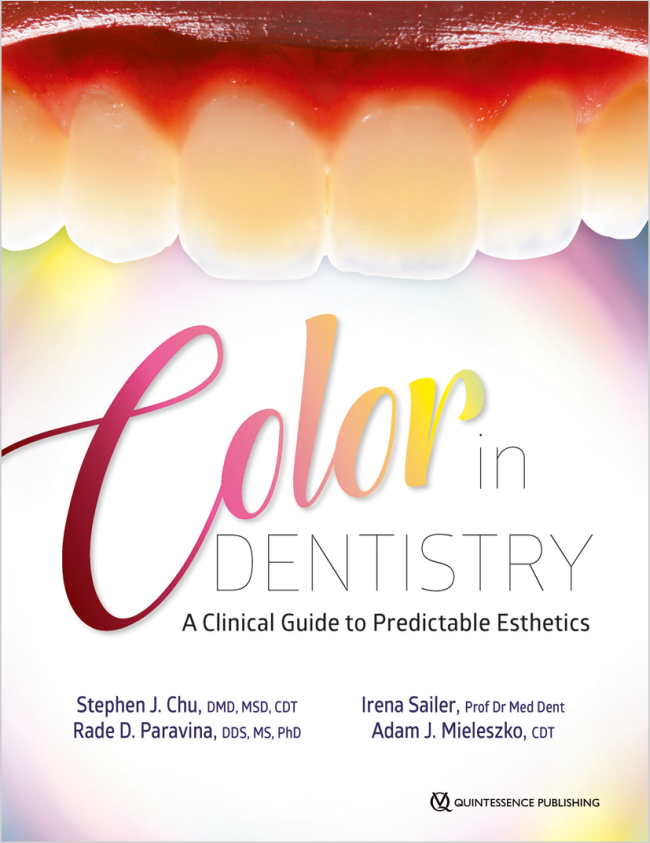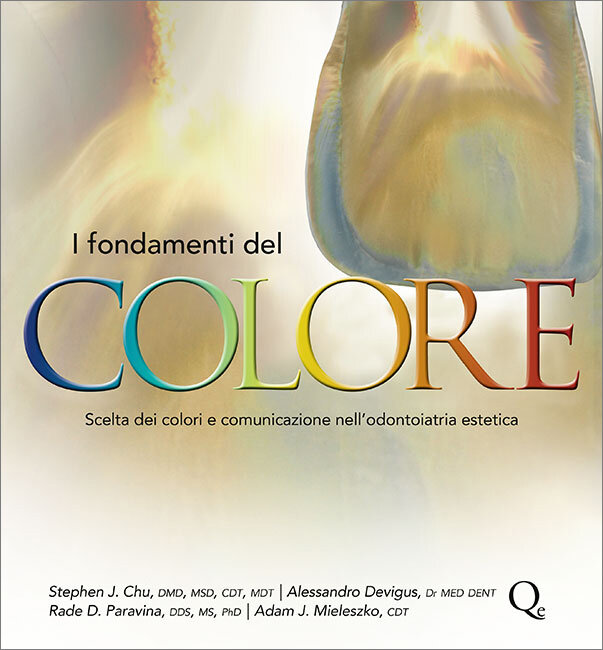International Journal of Periodontics & Restorative Dentistry, 3/2018
DOI: 10.11607/prd.3430, PubMed ID (PMID): 29641629Pages 397-403, Language: EnglishSarmast, Nima D. / Angelov, Nikola / Ghinea, Razvan / Powers, John M. / Paravina, Rade D.The CIELab and CIEDE2000 coverage error (ΔE*COV and ΔE'COV, respectively) of basic shades of different gingival shade guides and gingiva-colored restorative dental materials (n = 5) was calculated as compared to a previously compiled database on healthy human gingiva. Data were analyzed using analysis of variance with Tukey-Kramer multiple-comparison test (P .05). A 50:50% acceptability threshold of 4.6 for ΔE* and 4.1 for ΔE' was used to interpret the results. ΔE*COV / ΔE'COV ranged from 4.4/3.5 to 8.6/6.9. The majority of gingival shade guides and gingiva-colored restorative materials exhibited statistically significant coverage errors above the 50:50% acceptability threshold and uneven shade distribution.
Quintessence International, 9/2006
PubMed ID (PMID): 17017633Pages 713-719, Language: EnglishParavina, Rade D. / Kimura, Mikio / Powers, John M.Objective: The aim of this study was to evaluate color compatibility of corresponding resin composite shades keyed to Vitapan Classical shade guide (Vita).
Method and Materials: Twenty-one shades of 6 commercial resin composites were analyzed. Specimens (n = 5) were made as disks, 11 mm in diameter and 2 mm thick, using cylindrical molds. Specimens were polymerized according to manufacturers' suggestions using a light-curing unit. Data were collected using a spectrophotometer and analyzed using the appropriate color difference metric equations. A total color difference (DE*ab) greater than or equal to 3.7 was considered a mismatch. Analysis of variance and Fisher's probable least-squares difference (PLSD) test. intervals for comparison of means were calculated at the .05 level of significance.
Results: Mean DE*ab values among A2, B2, C2, and opaque A2 shade pairs were 4.4 (1.8), 7.3 (3.2), 5.6 (2.8), and 6.5 (1.8), respectively, while the mean color difference for all the pairs compared was 5.8 (2.8). For A2 shades, DL*, Da*ab, and Db*ab values ranged by 5.3, 2.3, and 6.7, respectively. Corresponding values for B2 shades ranged by 10.5, 2.2, and 11.5; 7.9, 2.2, and 4.3 for C2 shades; and 7.9, 1.4, and 4.4 for opaque A2 shades. Fisher's PLSD critical intervals for comparing DE*ab values among the shades and composite pairs were 0.07 and 0.15, respectively (P .0001, power 1.00).
Conclusion: Overall, poor color compatibility of shade pairs of identical shade designation was recorded. The best color match was recorded for A2 shade pairs, followed by C2, B2, and opaque A2 shade pairs.
Keywords: color, color measurement, dental materials, optical properties, resin composite, standardization, shade
The International Journal of Prosthodontics, 6/2002
Pages 528-534, Language: EnglishParavina, Rade D.Purpose: This study evaluated a newly developed visual shade-matching apparatus, Shademat Visual+, as well as the influence of tab arrangement, clinician gender, and years in practice on shade-matching quality.
Materials and Methods: A group of 129 colornormal evaluators-dental students and general dentists-matched the shade of four ceramometal crowns using the Vitapan Classical shade guide. Crowns were positioned onto the upper member of an artificial head and fastened to the headrest of the dental chair or Shademat Visual+. Shade tabs were arranged according to the manufacturer's suggestion or according to ΔE* in relation to the "lightest" tab and divided into groups (alternative arrangement). The evaluators matched the shade of four ceramometal crowns both in daylight and using the Shademat Visual+ artificial light source. The color coordinates were determined using digital image analysis. Based on ΔE* values, each shade-matching result was ranked from 1 (the worst match) to 16 (the best match) points.
Results: The evaluators achieved a better result in Shademat Visual+ trials than in daylight trials (13.2 points vs 12.4 points; P .001). For the same ceramometal crown, 12.7 points were recorded in daylight trials with the manufacturer-suggested arrangement, and 13.7 were recorded with the alternative arrangement (P .001). Corresponding values for Shademat Visual+ trials were 13.6 points and 14.6 points, respectively (P .001). Female-male and student-dentist evaluator differences were not significant.
Conclusion: The Shademat Visual+ apparatus enabled better shade-matching results than daylight. The alternative tab arrangement enabled better results than the manufacturer-suggested one. Gender and years in practice did not influence shade-matching quality.
The International Journal of Prosthodontics, 1/2002
Pages 73-78, Language: EnglishParavina, Rade D. / Powers, John M. / Fay, Rose-MariePurpose: The aim of this study was to analyze color parameters and color compatibility of two randomly chosen Vita shade guides, as well as to propose possible clinical guidelines.
Materials and Methods: Data were recorded using a colorimeter set to standard illuminant source C and the CIE L*a*b* system. A custom adapter system, which allowed a measuring area at the middle third of the tabs, was produced. Each of 42 tabs was recorded one time each on three different days. Color distribution was examined in diagrams whose coordinates were L*a*b* and L*C*H° color coordinate pairs. Color coordinate ranges and coverage error were examined using the corresponding equations and statistical methods.
Results: The method repeatability was approximately ΔE* = 0.1. Color difference ranges of Vitapan Classical and Vitapan 3D Master were 14.3 and 19.2, respectively. Color coordinate ranges of Vitapan Classical were as follows: ΔL* = 12.8; Δa* = 1.7; Δb* = 9.0; ΔC* = 9.0; and ΔH° = 7.4. Corresponding values for Vitapan 3D Master were ΔL* = 15.3; Δa* = 3.4; Δb* = 16.3; ΔC* = 16.6; and ΔH° = 10.5. Coverage error of Vitapan 3D Master to Vitapan Classical was 1.4 ± 0.6, while vice versa it was 2.0 ± 1.5.
Conclusion: Compared to Vitapan Classical, chromaticity ranges of Vitapan 3D Master were extended in the desired directions: hue was extended toward yellow-red, and saturation was extended toward more saturated tabs. Compared to Vitapan Classical, Vitapan 3D Master tabs were more uniformly spaced. The examined shade guides were found to be color compatible.





